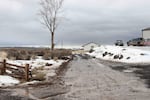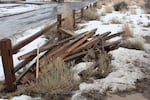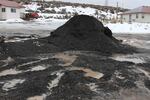
The U.S. Fish and Wildlife Service confirmed that this road within the refuge complex is new construction.
Amanda Peacher / OPB
The armed occupiers of the Malheur National Wildlife Refuge continue to use government equipment inside the complex.
One militant, who refused to give his name, again plowed dirt with a refuge bulldozer Wednesday. He wouldn't say why he was operating the machinery, but in several places, sagebrush and vegetation had been newly removed, leaving wide patches of bare mud within the complex.
The new road connects a bunkhouse with another road.
When asked about the construction, the militant claimed that the road was already there, and that militants had only removed snow from the path.

The U.S. Fish and Wildlife Service says these fence posts were newly removed since the occupation. The road now cuts through the previously fenced area.
Amanda Peacher / OPB
The U.S. Fish and Wildlife Service confirmed Thursday that not only is the road built last week by the occupiers new, but it is also within an archaeological site important to the Burns Paiute Tribe.
The U.S. Fish and Wildlife Service assistant director of external affairs, Jason Holm, condemned the militants last week for what he called “disgusting, ghoulish behavior.”
They removed part of a fence to create the short access road.
That fence was in place "as a deterrent to keep fire crews from driving across the archaeological site," said Holm.
It appears militants moved rocks from an existing gravel pile in the compound to surface the road.
"It was just a goat trail before,” one militant told OPB, who also declined to provide his name. “People were slipping and falling.”

Rocks used to surface the newly constructed road within the refuge appear to have been moved from a stockpile onsite.
Amanda Peacher / OPB
Kevin Foerster, the agency's Pacific region chief, also denounced the construction.
"There's a reason why there's not a road there," said Foerster. "If there was a need for a road in that particular location, we would have over the past 108 years put a road in that location."
The agency said the action is likely a violation of the Archaeological Resources Protection Act, also known as the ARPA.
"Even disturbing 3 to 4 inches on the surface is an ARPA violation," said Holm. "Investigators will have to excavate to determine depth of disturbance in several areas to understand the extent of the damage."